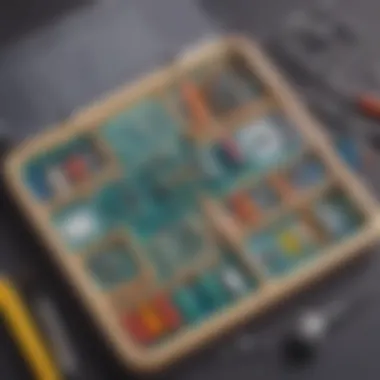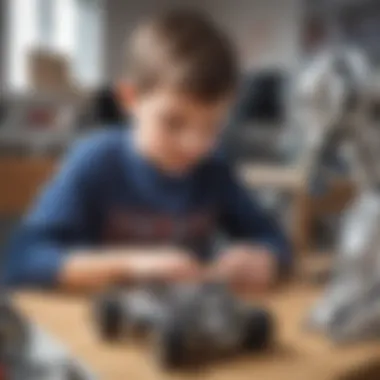Unveiling the Advantages of Utilizing STEM Kits in Classroom Settings


Science Fun Facts
STEM kits offer a unique way for young minds to engage with science through hands-on exploration. Diving into scientific concepts like physics, chemistry, and engineering from an early age can spark a lifelong passion for learning. These kits often contain fascinating tidbits of information, such as how magnets work or the wonders of simple machines. By encouraging curiosity and providing a tangible connection to science, STEM kits create a foundation for deeper understanding.
Discover the Wonders of Science
When children open a STEM kit, they enter a world where scientific principles come to life. From building a basic circuit to constructing a model volcano, these kits offer interactive tools that make learning enjoyable and memorable. Animated videos and simulations further enhance the educational experience, allowing young learners to visualize abstract concepts with ease. Real-life applications of scientific theories provide context, showing children how science impacts their daily lives.
Science Quiz Time
Engaging young learners with interactive quizzes and brain teasers is a fun way to reinforce scientific knowledge. Multiple-choice questions challenge children to think critically and apply what they have learned from STEM kits. By incorporating gamification elements, such as rewards and friendly competition, these quizzes transform learning into an exciting adventure. Whether tackling puzzles or pondering thought-provoking questions, quizzes provide a dynamic way to test understanding and promote deeper engagement.
Science Experiment Showcase
The heart of STEM education lies in hands-on experimentation, and STEM kits deliver a wealth of exciting activities. From creating slime to exploring the power of solar energy, these kits guide children through captivating experiments step by step. Each experiment comes with a detailed list of materials, ensuring easy setup and execution. Safety tips and precautions emphasize the importance of responsible scientific exploration, teaching young learners to prioritize their well-being while uncovering the wonders of the natural world.
Introduction
The inception of the 21st century has witnessed a seismic shift in educational paradigms, with a notable emphasis placed on Science, Technology, Engineering, and Mathematics (STEM) education. As we navigate through this era of rapid technological advancement and innovation, integrating STEM kits in classroom settings has emerged as a pivotal strategy to foster a dynamic learning environment for young learners. These kits serve as educational catalysts, propelling students into an exciting realm where theoretical concepts seamlessly blend with practical applications.
In this article, we delve into the transformative potential of STEM kits within educational landscapes, particularly focusing on children between the ages of 6-12. By shedding light on various aspects such as the interactive nature of these kits, the creativity they ignite, and the crucial role they play in hands-on learning experiences, we aim to provide a comprehensive exploration of their benefits for classrooms. Understanding the significance of incorporating STEM kits is essential to harnessing the full spectrum of learning opportunities they offer, paving the way for a generation that is not just academically proficient but also adept at critical thinking and problem-solving.
By unraveling the layers of STEM education and emphasizing the integral role played by these kits, we aim to equip educators, parents, and caregivers with the knowledge and insight needed to make informed decisions regarding the integration of STEM resources into the educational journey of young minds. Through a nuanced analysis of the benefits, considerations, and practical implications of incorporating STEM kits in classrooms, this article seeks to empower stakeholders in fostering a holistic and engaging learning experience that transcends traditional textbook-based approaches.


Understanding STEM Education
STEM education plays a crucial role in the holistic development of young minds. In this article, we focus on the specific aspects that make STEM education a transformative experience for children aged 6-12. By integrating Science, Technology, Engineering, and Mathematics, STEM education fosters a multidisciplinary approach to learning, emphasizing problem-solving, innovation, and creativity. The incorporation of STEM kits in classrooms enhances the experiential learning process, making complex concepts more accessible and engaging for students.
What is STEM Education?
STEM education is a progressive learning methodology that integrates science, technology, engineering, and mathematics to cultivate critical thinking, analytical skills, and practical knowledge among students. By merging these core disciplines, STEM education encourages hands-on exploration, experimentation, and application of theoretical concepts. This approach not only prepares students for future career opportunities but also nurtures a deep-seated curiosity for scientific inquiry and discovery.
Importance of STEM Learning
STEM learning is essential for equipping students with the necessary skills to thrive in a technology-driven world. By engaging in STEM activities, children develop crucial problem-solving abilities, analytical thinking patterns, and the capacity to work collaboratively towards finding innovative solutions. Moreover, STEM learning instills a sense of resilience, adaptability, and ingenuity in students, empowering them to tackle real-world challenges with confidence and competence.
Incorporating Hands-On Learning
Hands-on learning is a cornerstone of effective STEM education. By incorporating hands-on experiences through STEM kits, students can actively engage with scientific phenomena, conduct experiments, and witness theoretical concepts in practical scenarios. This tactile approach not only enhances retention and comprehension but also cultivates a genuine interest in STEM subjects among young learners. Through hands-on learning, students develop a deeper appreciation for the application of scientific principles in real-life situations, paving the way for a lifelong passion for discovery and innovation.
Benefits of STEM Kits
STEM kits play a vital role in enhancing the learning journey of young science enthusiasts aged 6-12. These kits offer a hands-on approach to exploring scientific concepts, making the learning process interactive and engaging. By integrating STEM kits into classrooms, educators can provide a holistic learning experience that goes beyond traditional teaching methods. Students have the opportunity to apply theoretical knowledge to practical situations, fostering a deeper understanding of STEM subjects.
Enhancing Critical Thinking Skills
STEM kits promote the development of critical thinking skills by encouraging students to analyze information, think logically, and solve complex problems. Through hands-on activities and experiments, students learn how to approach challenges methodically, evaluate evidence, and make informed decisions. By engaging in STEM tasks that require experimentation and exploration, students enhance their problem-solving abilities and develop a more analytical mindset.


Encouraging Creativity and Innovation
One of the key benefits of STEM kits is their ability to nurture creativity and innovation in young learners. By allowing students to design, build, and test their ideas, these kits inspire out-of-the-box thinking and imaginative problem-solving. Through hands-on experimentation, students unleash their creativity, explore new possibilities, and learn to embrace failure as a stepping stone to innovation.
Fostering Collaboration and Problem-Solving
STEM kits promote collaboration among students as they work together to complete projects and solve problems. By engaging in group activities, students learn to communicate effectively, share ideas, and compromise to achieve common goals. This collaborative environment not only enhances teamwork skills but also teaches students the value of different perspectives in problem-solving.
Bridging Theory with Practice
A significant advantage of STEM kits is their ability to bridge theoretical knowledge with practical application. By immersing students in hands-on activities related to STEM concepts, these kits provide tangible experiences that reinforce classroom learning. Students gain a deeper understanding of abstract theories by seeing how they work in real-world scenarios, thereby strengthening the connection between theoretical concepts and practical implementation.
Selection of STEM Kits
STEM kits play a crucial role in enhancing the learning experience for young students within the subject areas of Science, Technology, Engineering, and Mathematics (STEM). By providing hands-on opportunities to engage with scientific concepts, these kits offer a practical approach to learning that bridges the gap between theory and application. One of the key benefits of using STEM kits in classrooms is their ability to enhance critical thinking skills among students. Through interactive exercises and experiments, students are encouraged to analyze problems, think creatively, and develop innovative solutions. Additionally, STEM kits foster collaboration and problem-solving skills by promoting teamwork and communication among students. By working together to complete projects and solve challenges, students learn how to collaborate effectively and tackle problems cooperatively. Furthermore, STEM kits help students develop a deeper understanding of STEM subjects by allowing them to explore concepts in a hands-on manner. This tactile learning approach helps students apply theoretical knowledge to real-world scenarios, reinforcing their comprehension and retention of key principles.
Considerations for Classroom Integration
When integrating STEM kits into the classroom, educators must consider various factors to ensure optimal learning outcomes for students. Firstly, it is essential to select kits that align with the curriculum objectives and learning goals of the classroom. By choosing kits that complement the existing curriculum, teachers can enhance the relevance and applicability of STEM concepts for students. Additionally, educators should adapt STEM kits to accommodate different learning styles among students. By providing a variety of activities and challenges that cater to visual, auditory, and kinesthetic learners, teachers can ensure that all students have the opportunity to engage meaningfully with the material. Finally, STEM kits should align with curriculum standards to ensure that students are meeting the educational benchmarks set by governing bodies. By integrating kits that align with specific standards and competencies, educators can track student progress more effectively and provide targeted support where needed.
Adapting to Different Learning Styles
Aligning with Curriculum Standards


Implementation Strategies
Integration into Lesson Plans
Integration of STEM kits into lesson plans serves as a fundamental step towards maximizing their impact on students' learning outcomes. By seamlessly incorporating hands-on activities and interactive experiments using STEM kits, educators can create a dynamic learning environment that stimulates curiosity, encourages exploration, and reinforces key scientific concepts. Through structured lesson plans that integrate STEM kits, teachers can design targeted activities that cater to diverse learning styles, ensuring optimal engagement and comprehension among students. Furthermore, the strategic alignment of STEM kit integration with curriculum standards enables educators to cover essential topics while fostering a deeper understanding of complex scientific principles through practical application.
Facilitating Student Engagement
Facilitating student engagement with STEM kits is essential for creating a stimulating and enriching learning experience. By providing students with opportunities to explore, experiment, and problem-solve using hands-on activities, educators can ignite a passion for science and foster a sense of curiosity and discovery. Engaging students actively in the learning process through interactive STEM activities not only enhances their understanding of scientific concepts but also cultivates essential skills such as collaboration, critical thinking, and perseverance. Moreover, by creating a supportive and encouraging learning environment, educators can empower students to take ownership of their learning journey and develop a lifelong love for STEM subjects.
Promoting Continuous Learning
Promoting continuous learning through the utilization of STEM kits ensures that students remain actively engaged and motivated to explore the fascinating world of science continuously. By incorporating a variety of STEM activities that build upon previous knowledge and introduce new challenges, educators can nurture a growth mindset in students, encouraging them to embrace intellectual curiosity, adaptability, and resilience. Moreover, by incorporating opportunities for self-directed learning and exploration, educators can instill a sense of independence and creativity in students, fostering a love for lifelong learning and a deep appreciation for the wonders of science.
Impact of STEM Kits
STEM kits play a pivotal role in revolutionizing the traditional classroom setting by fostering a dynamic learning environment where students actively engage with science, technology, engineering, and math concepts. Through hands-on experimentation and exploration, STEM kits enable students to develop critical thinking skills, problem-solving abilities, and a deeper understanding of scientific principles. By immersing young learners in experiential activities, these kits ignite a passion for learning and encourage curiosity towards the world around them. Furthermore, STEM kits provide a platform for students to apply theoretical knowledge to real-world scenarios, bridging the gap between classroom learning and practical application.
Measuring Learning Outcomes
Encouraging Career Exploration
Building Confidence and Resilience
Conclusion
Moreover, the integration of STEM kits in classrooms bridges the gap between theory and practical application, giving students the opportunity to engage with scientific concepts in a tangible and experiential manner. This hands-on approach not only reinforces theoretical knowledge but also instills a deeper understanding of how concepts work in real-life scenarios. When considering STEM kit selection, educators must focus on factors such as classroom integration, adapting to different learning styles, and aligning with curriculum standards to maximize the educational benefits for students across diverse backgrounds.
From an implementation perspective, incorporating STEM kits into lesson plans is essential to enhance student engagement and promote continuous learning. By seamlessly integrating these kits into existing curricula, educators can create dynamic and interactive lessons that capture students' interest, encourage active participation, and cultivate a passion for STEM disciplines. This approach not only enriches the learning experience but also empowers students to explore their interests, develop valuable skills, and prepare for future academic and professional endeavors.
When assessing the impact of STEM kits on learning outcomes, it becomes evident that these educational tools play a pivotal role in measuring academic progress, fostering career exploration, and building confidence and resilience in young learners. By evaluating the effectiveness of STEM kits in enhancing critical skills and shaping career aspirations, educators and parents can gain valuable insights into the long-term benefits of integrating these tools into educational practices. Overall, the utilization of STEM kits in classrooms offers a holistic approach to learning that nurtures curiosity, promotes innovation, and prepares students for success in a rapidly evolving world.







